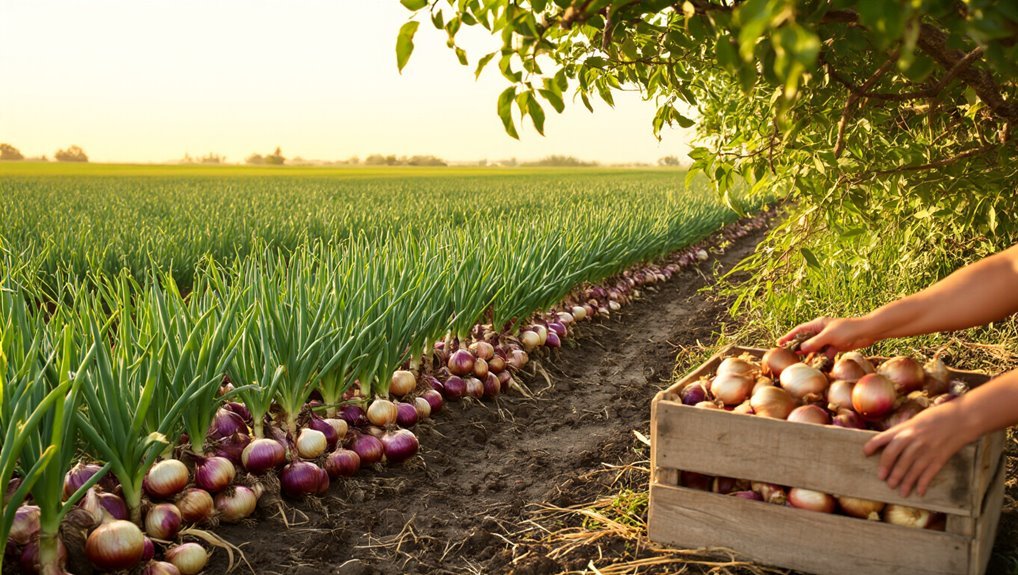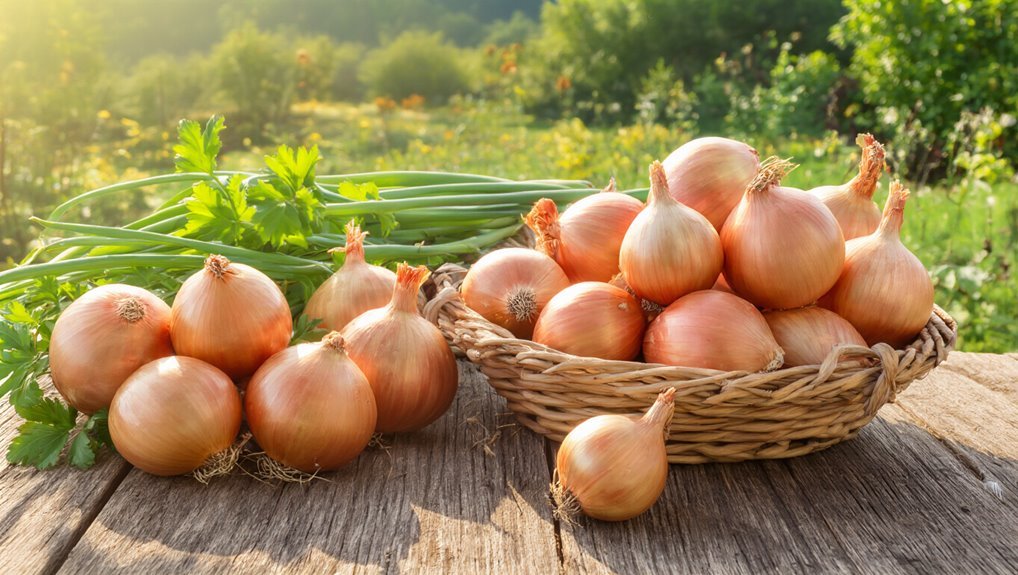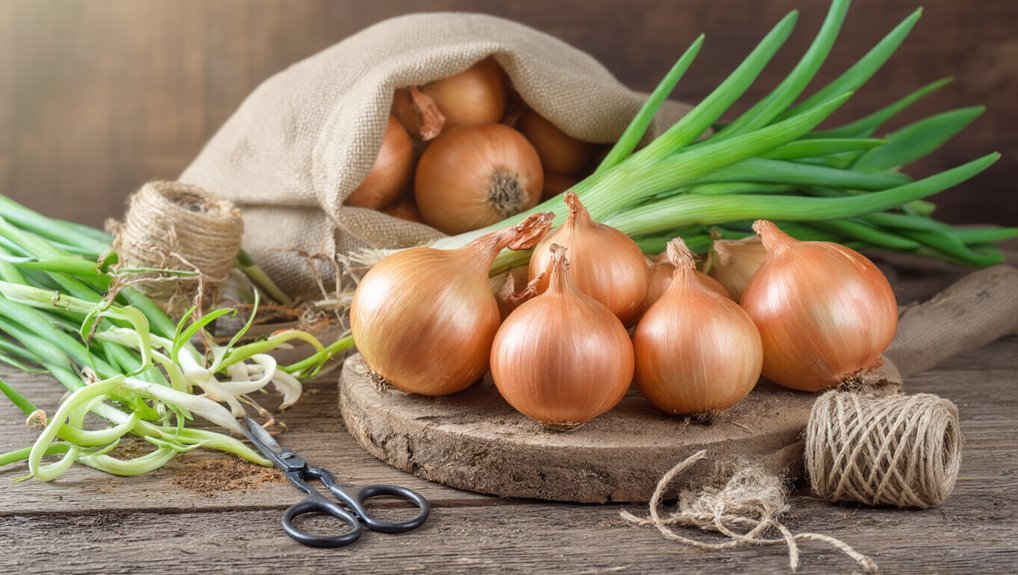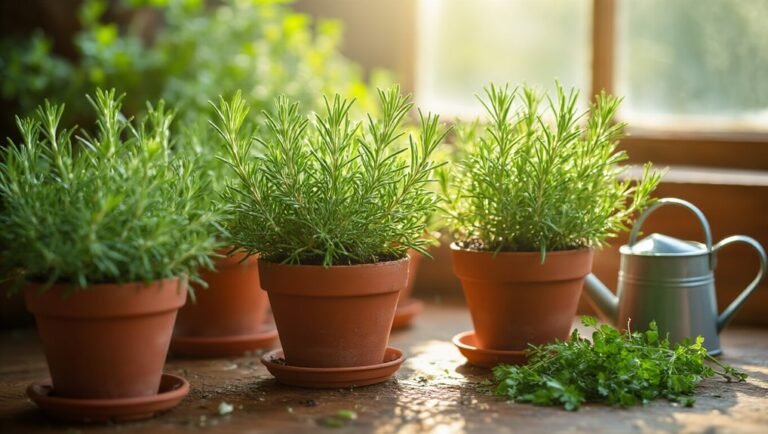To cure onions for long-term storage, gently pull them from the soil after the tops have yellowed and fallen over. Shake off excess dirt without washing them and trim the roots while keeping the tops intact. Lay the onions in a warm, dry space (75°F to 80°F) for two to three weeks, avoiding sunlight. Once cured, store them in a cool, dark place with good ventilation. You’ll find more tips on maintaining their freshness and preventing spoilage.
Key Takeaways
- Harvest onions when tops are yellow and fallen, ensuring they are mature for curing.
- Cure onions in a warm, dry, well-ventilated space for 2-3 weeks until necks are dry.
- Lay onions in a single layer, avoiding overlap to allow for proper air circulation.
- Store cured onions in a cool, dark place with good ventilation at 30°F to 50°F.
- Regularly inspect stored onions for spoilage and remove any affected onions immediately.
Harvesting Onions at the Right Time

To ensure your onions store well, you need to harvest them at the right time.
Watch for signs that indicate maturity: the tops should start to yellow and fall over. This usually happens when the onions have reached their full size, typically in late summer or early fall.
Dig them up gently to avoid bruising, and be cautious not to leave any in the ground too long, as this can lead to rot. If you notice any soft spots or signs of disease, harvest those onions first.
Timing is crucial, so keep an eye on the weather; a dry spell is ideal for harvesting, as excess moisture can impact their storage life. For gardeners interested in sustainable practices, investing in outdoor composting systems can help manage garden waste efficiently.
Harvesting at the right moment sets your onions up for successful curing.
To make your garden more sustainable, consider using compost bins to recycle onion tops and other plant waste after harvest.
Preparing Onions for Curing
Once you’ve harvested your onions, the next step is preparing them for curing. Start by gently pulling the onions from the soil, avoiding any bruising or damage.
Shake off excess dirt, but don’t wash them, as moisture can lead to rot. Next, trim the roots to about an inch, but leave the tops intact for now. If you notice any damaged or diseased onions, remove those immediately to prevent spoilage.
To further protect your onions as they dry, you might consider laying them on a bed of organic mulching materials such as straw, which can improve air circulation and reduce the risk of rot.
Then, spread the onions out in a single layer in a well-ventilated area, away from direct sunlight. This helps them dry out while maintaining their quality.
Using high-quality garden soil during the growing season can improve onion health and lead to better results during curing and storage.
Proper preparation sets the foundation for successful curing, ensuring your onions store well for months to come.
Curing Process: Steps to Follow

As you begin the curing process, it’s crucial to find a warm, dry, and well-ventilated space where your onions can thrive. Aim for temperatures around 75°F to 80°F for optimal curing. Using grow bags can help with air circulation and drainage when drying freshly harvested onions.
Lay your onions in a single layer, avoiding any overlap, to promote air circulation.
- Keep them out of direct sunlight to prevent spoilage.
- Allow the onions to cure for about two to three weeks until their necks are dry and the skins are papery.
- Regularly check for any signs of rot or mold, removing affected onions immediately.
If you’re planning to grow onions from seed in the future, starting with seed starting kits can help ensure healthy seedlings for next year’s harvest. Once cured, you’ll be ready to store your onions properly for long-term use. Following these steps ensures you maximize their shelf life and enjoy their flavor for months to come.
Ideal Storage Conditions for Cured Onions
While you might be eager to store your cured onions, ensuring the right conditions is vital for maintaining their quality.
First, find a cool, dark place with good ventilation; a temperature between 30°F and 50°F is ideal. Avoid humid areas, as moisture can lead to rot. Use mesh bags, baskets, or crates to promote airflow. For optimal airflow and connection, consider using garden hose connectors and adapters to set up watering or rinsing stations near your storage area.
Keep your onions away from direct sunlight, which can cause them to sprout. Aim for a humidity level around 60%.
Regularly check your stored onions for signs of spoilage, removing any affected ones promptly.
If you need to rinse dirt off before curing, using garden hoses can make the process easier and more efficient.
Tips for Maintaining Onion Freshness

After you’ve stored your cured onions in the right conditions, maintaining their freshness becomes your next focus.
To keep your onions crisp and flavorful for as long as possible, follow these simple tips:
- Check regularly: Inspect your onions weekly for any signs of sprouting or decay. Remove any affected onions immediately to prevent the spread.
- Keep them cool: Store your onions in a cool, dark place to avoid premature sprouting and spoilage. A temperature between 32°F and 50°F works best.
- Avoid moisture: Ensure your storage area has good ventilation to prevent humidity buildup, which can lead to mold and rot.
Frequently Asked Questions
Can I Cure Onions in a Humid Environment?
Curing onions in a humid environment isn’t ideal. High moisture can lead to rot and mold. You’ll want to find a dry, well-ventilated space to ensure your onions cure properly and last longer.
How Long Do Cured Onions Last?
Cured onions can last several months, often up to 6-8 months, if stored properly. Keep them in a cool, dry place with good air circulation, and you’ll enjoy their flavor for a long time.
What Types of Onions Are Best for Curing?
When you’re choosing onions for curing, opt for varieties like Yellow onions, Red onions, and Sweet onions. They have thicker skins, which help them store longer and maintain their flavor during extended periods.
Should I Wash Onions Before Curing?
You might think washing onions is essential, but it’s not. You shouldn’t wash them before curing, as moisture can promote rot. Instead, brush off dirt gently and let them dry thoroughly for best results.
How Do I Know if Onions Are Fully Cured?
To know if onions are fully cured, check their outer skins. They should be papery and dry. The necks should be tight, and the bulbs should feel firm. If they’re soft, they need more curing time.
Conclusion
As you close the chapter on your onion journey, think of your onions as cherished stories waiting to be told. By harvesting at the right time and nurturing them through the curing process, you’ve crafted a tale of preservation that can last through seasons. Store them in the ideal conditions, and they’ll whisper their flavors into your meals for months to come. With a little care, your onions will remain vibrant characters in your kitchen saga!


